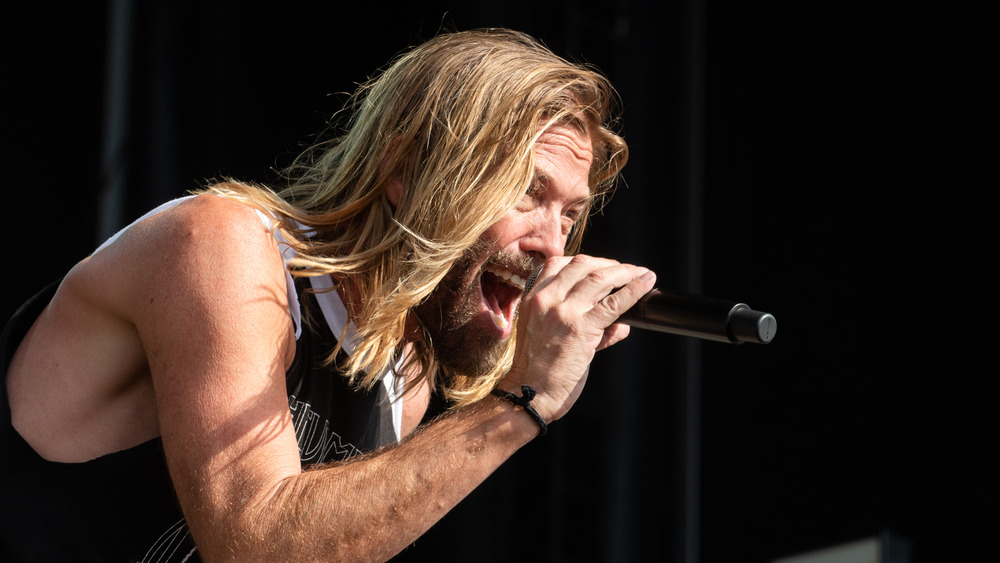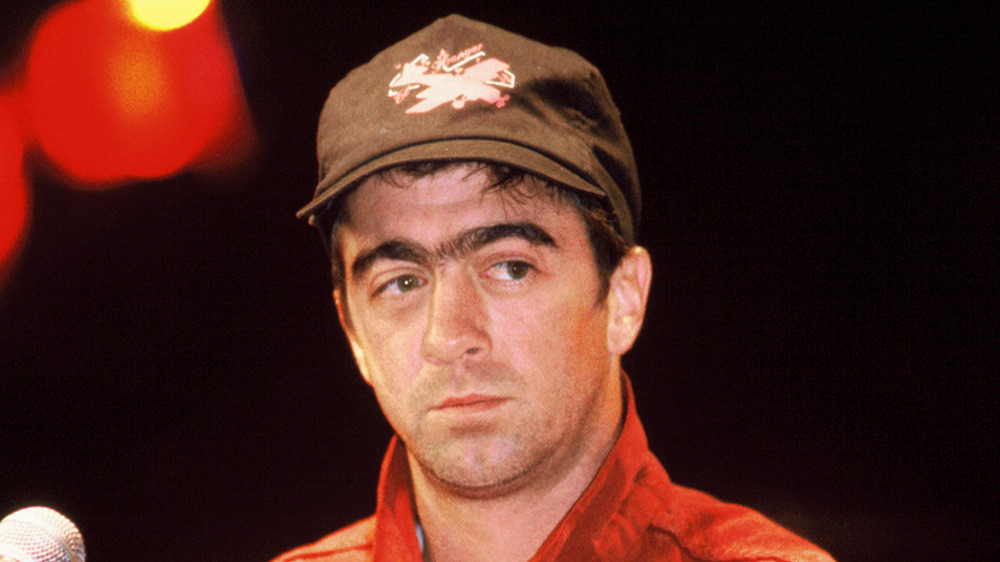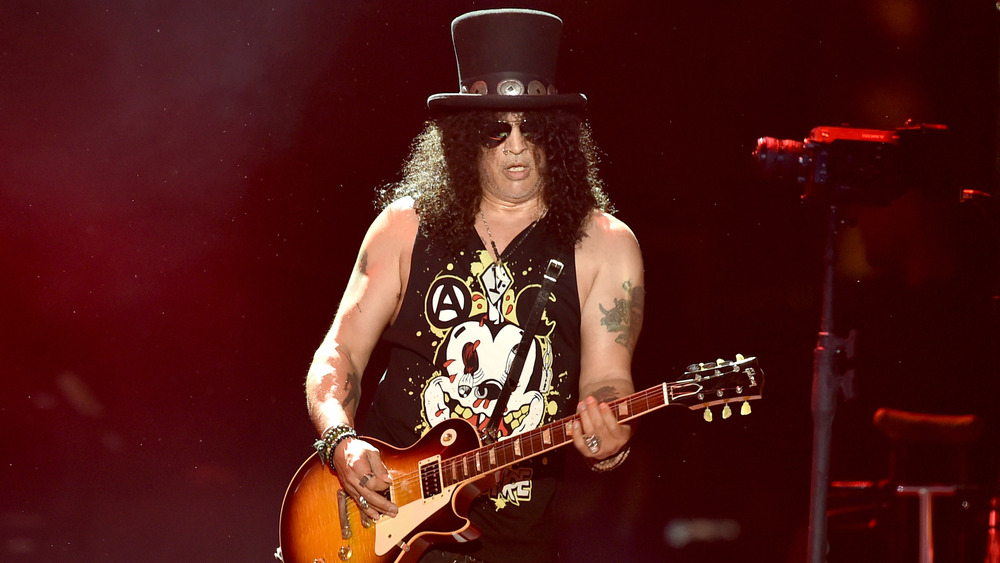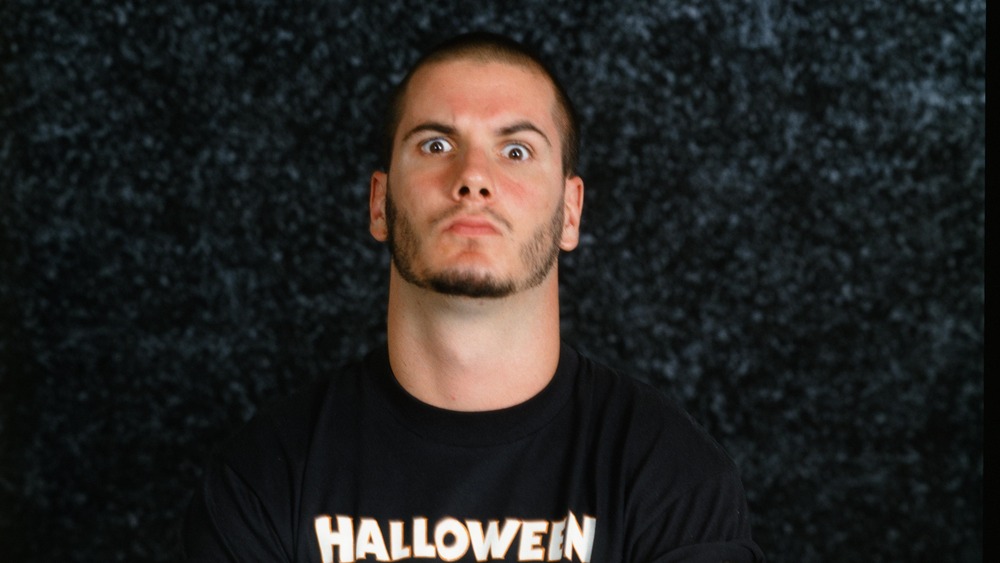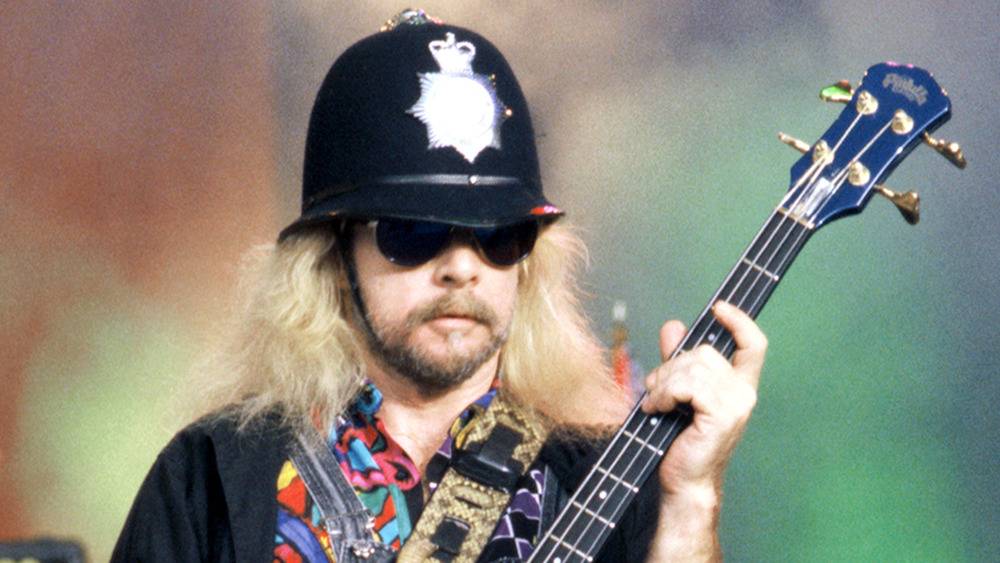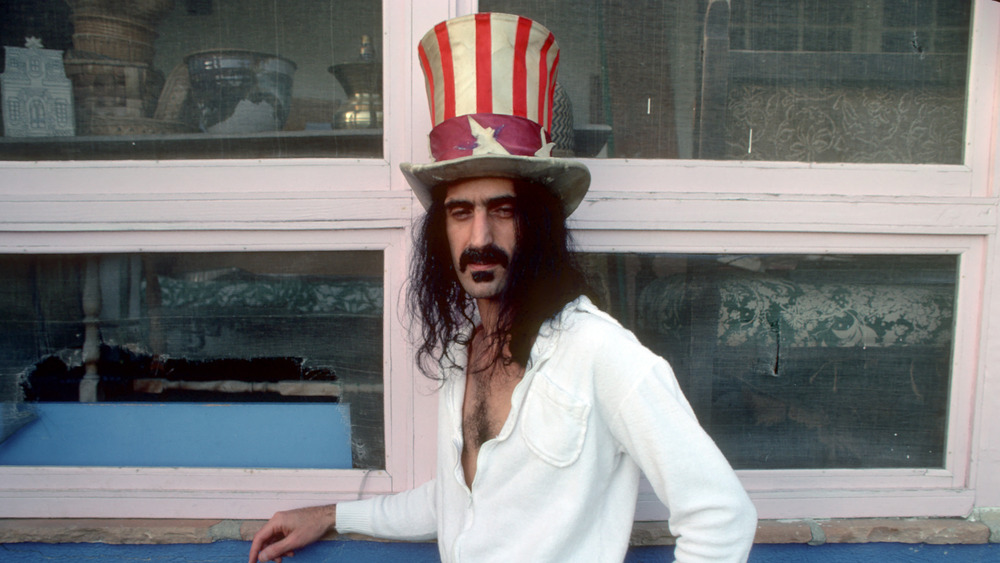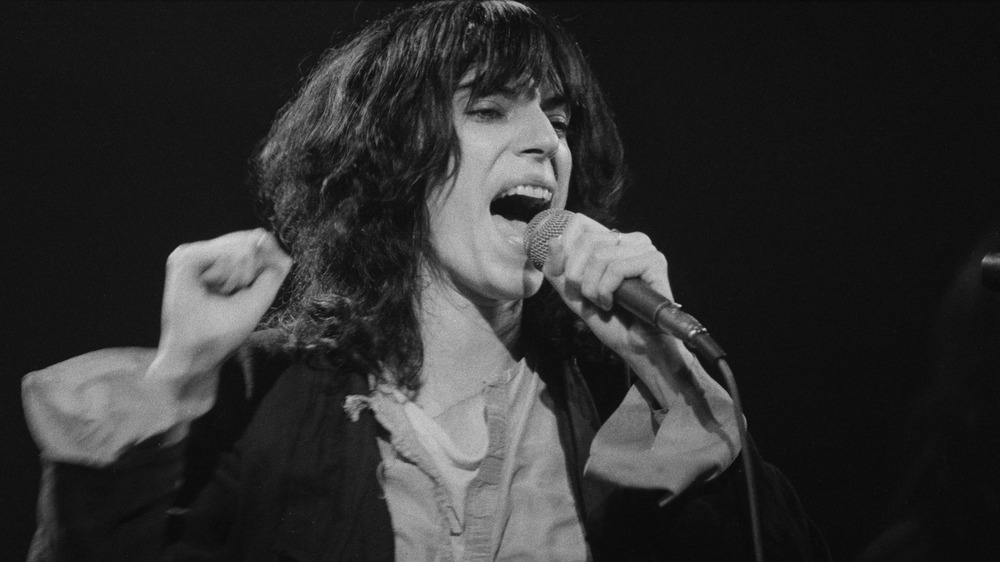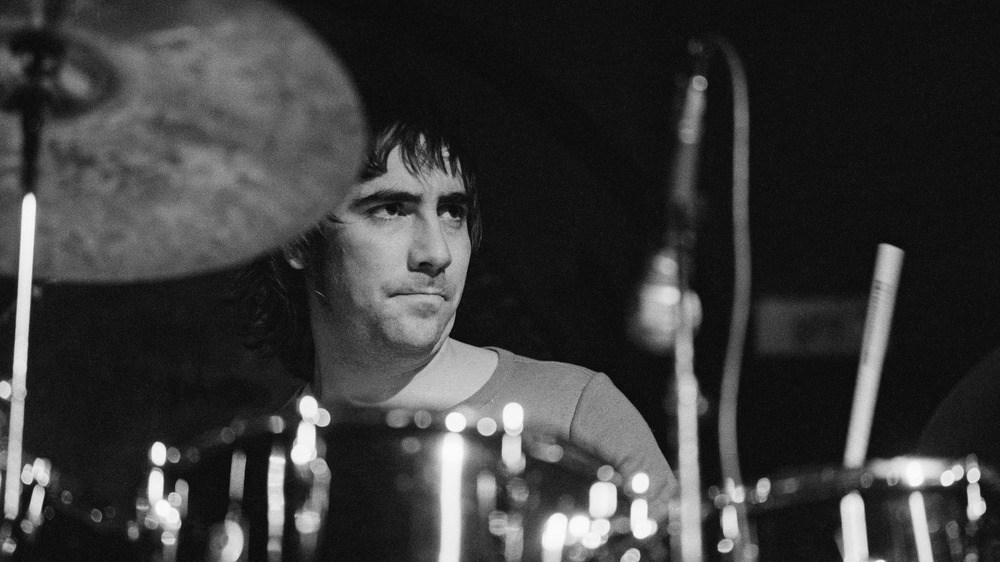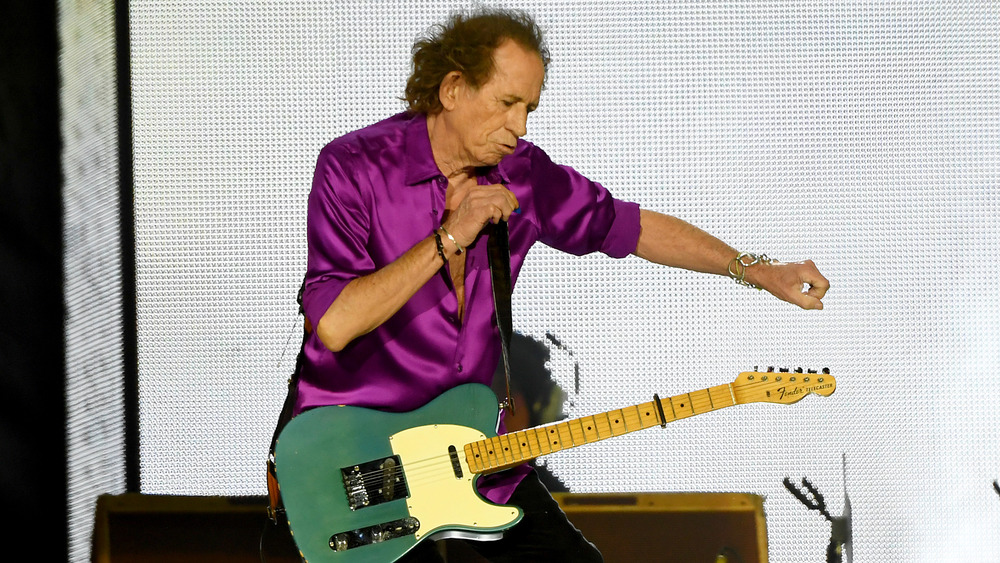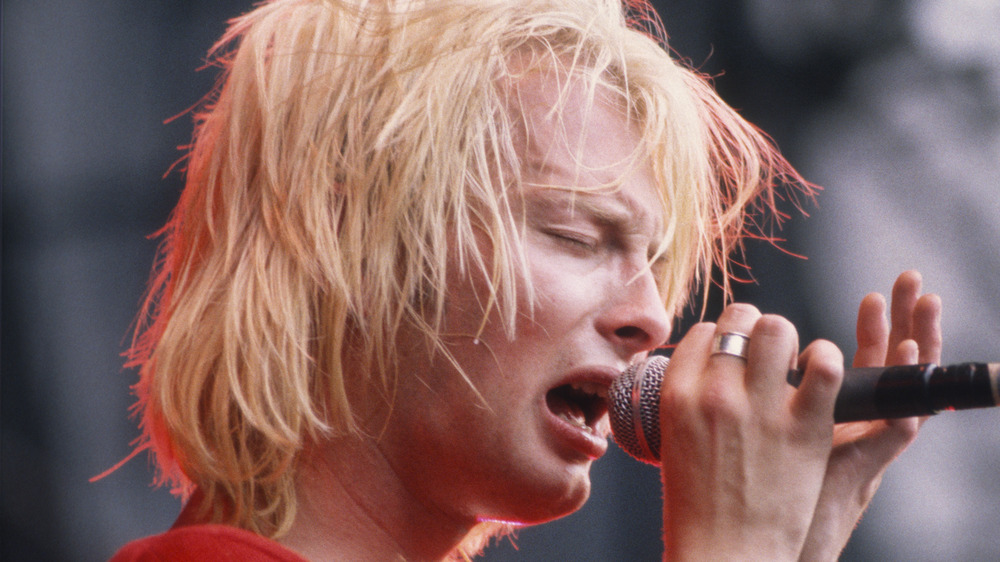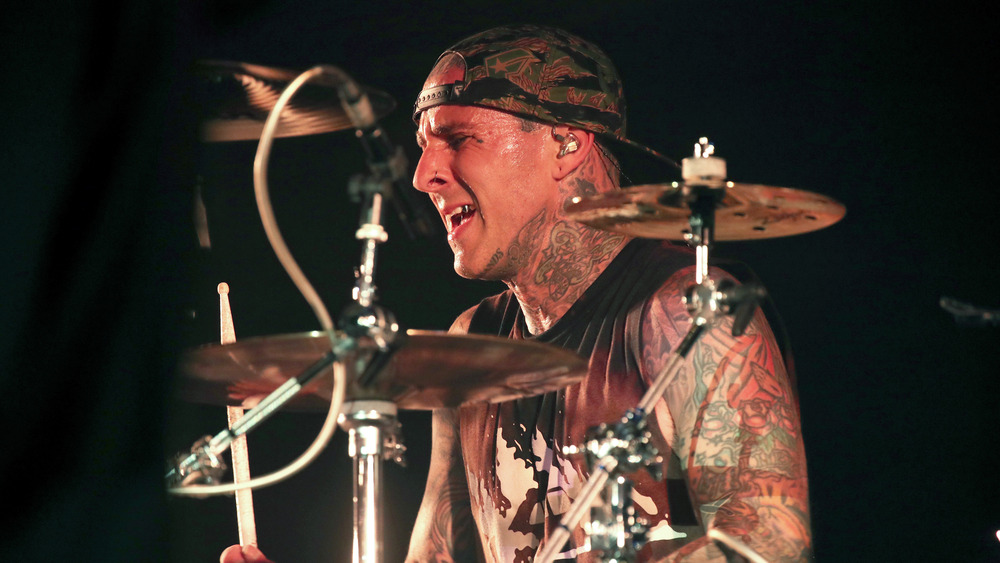Rock Stars That Nearly Died On Tour
The life of a famous rock star isn't all about writing great songs and enjoying the money and assorted benefits that being a well-known rocker inevitably brings. Sometimes, there's also work to be done. Take touring, for instance. Sure, it's probably amazing to play your songs to the adoring masses all over the country, or even the world. The thing is, to get from gig A to gig B to the rest of the Gig Alphabet means a whole bunch of rigorous traveling ... and when rockers hit the road, anything can happen.
Some bands become absolute nightmares on tour. Others experience tragic accidents. Even if everything starts out smoothly and the artists behave themselves, there may be all sorts of technical malfunctions, logistical issues, and even outright risky situations. All in all, tours are a veritable buffet of disasters that range from small setbacks to a surprisingly large number of life-threatening incidents. In fact, there's a decent chance that at some point in their careers, some of your favorite rockers have almost lost their lives in strange tour mishaps. Let's take a look at the strange stories of rock stars that nearly died on tour.
Eric Clapton's multi-ulcer close call
Eric Clapton, guitarist extraordinaire and a nigh-constant presence on the rock scene since the 1960s, has overcome a tragic life to fight for the best seats in the rock 'n' roll pantheon. However, as Ultimate Classic Rock tells us, old Slowhand's musical ability and success have come with a great number of personal demons. His appetite for drink and drugs used to be life-destroyingly copious, and it didn't make things any easier that he wasn't really facing the fact that he was an addict.
On his 1981 U.S. tour, things came to a head in a dramatic way. On March 13, 1981, Clapton had just wrapped up a show in Madison, Wisconsin, when suddenly, a brutal pain hit him. "We flew to St. Paul, Minnesota, where Roger [Forrester] had me rushed to a hospital," the musician described the situation in his self-titled autobiography (via Ultimate Classic Rock). "I was diagnosed with five bleeding ulcers; one was the size of a small orange. The doctors told Roger, who wanted to fly me back to England, that I could die at any moment since one of the ulcers was pressing on my pancreas, and could burst imminently."
Clapton ultimately avoided this grim fate and was able to return to work after a quite literally sobering stint in the hospital. Unfortunately, he was soon hitting the bottle again. Per The Fix, he didn't fully sober up until after his son's death in 1991.
David Bowie's blocked artery ended his touring for good
David Bowie's career was full of art and great tunes, and as Biography tells us, even his 2016 death came with a soundtrack of sorts — his final album, Blackstar. However, his career — and life — almost had a much earlier ending. You may have noticed that Bowie wasn't one of those artists who toured the globe well into their sixties, and as Diffuser reports, there was a very good reason for that. During his A Reality Tour in 2004, a blocked artery gave him a serious health scare after a show in Germany, and although emergency surgery saved him, the incident caused Bowie to consider ending his career altogether.
Bowie was 57 at the time, and although he appeared as ageless and animated as ever, his band had started to notice that he wasn't all that well. He'd already started displaying symptoms during an earlier date in the Czech Republic, but it wasn't until the June 25 gig at the Hurricane Festival when things really took a dark turn. "We played the entire set and it seemed normal, not quite as energetic and as charged as the performance before," Bowie's guitar player, Gerry Leonard said. "We finished the show and then it seemed like David was in a lot of pain, and obviously something was wrong." Though the artist survived the ordeal and carried on his career, his touring days were done.
James Hetfield's magnesium pyro incident
Metallica's singer-guitarist James Hetfield has had two brushes with death on tour. As Ultimate Classic Rock writes, the first happened on September 26, 1986, when the thrash metal giants were touring Europe, and a bad bus accident in Sweden killed their bassist, Cliff Burton. Fortunately, as Scott Ian of Metallica's warm-up band Anthrax told in his book, I'm the Man: The Story of That Guy From Anthrax (via Loudwire), the other band members survived the tragedy with few injuries.
Hetfield's second close call was in 1992 when, as Uproxx reports, Metallica were co-headlining a Lollapalooza tour with Guns N' Roses. In Montreal, a miscommunication with a pyrotechnician led to a situation in which Hetfield was far too close to a magnesium flame when it went off. "I walk forward, I walk back, the pyro guy doesn't see me and 'whoosh' a big colored flame goes right up under me," the Metallica man described the situation. "I'm burnt — all my arm, my hand completely, down to the bone. The side of my face, hair's gone. Part of my back. I watched the skin just rising, things going wrong."
Luckily, Hetfield survived his painful ordeal, and the band resumed touring a few weeks later — though it was a while before he played guitar again. To put in context just how dangerous the incident was, bassist Jason Newstead later said (via Far Out Magazine): "If he had been breathing in, he would have been dead."
Taylor Hawkins goes into a coma
For all intents and purposes, it seems that The Foo Fighters' Taylor Hawkins would lead a pretty charmed rock star life. Playing drums in one of the biggest bands of the world, having the notoriously nice (unless you're Courtney Love) Dave Grohl as a bandmate ... what's not to like? The problem is, according to Ultimate Classic Rock, that at one point, Hawkins liked it all a little too much.
In 2001, MTV News reported that Hawkins had been hospitalized, and the Foo Fighters had called it quits on the final four concerts of their European tour. It eventually came to light that the drummer had overdosed on heroin so severely that he spent two weeks in a coma.
Hawkins has been known to somewhat downplay the life-threatening incident itself, saying that he merely liked to party a bit too hard, referring to his time in a coma as a "happy nap" and seemingly expressing more concern at whether the Foo Fighters would survive this hurdle or not. However, that's not to say Hawkins didn't take the admittedly pretty drastic wake-up call to heart. "There was a year where the partying just got a little too heavy," the drummer told Beats 1 (via Ultimate Classic Rock) in 2018. "And thank God, on some level this guy gave me the wrong line or the wrong thing one night, and I woke up going, 'What the f*ck happened?' That was a real changing point for me."
R.E.M.'s Bill Berry had a brain aneurysm in the middle of a show
In 1995, alt-rock superstars R.E.M. were touring the globe in support of their Monster album, but the tour turned out to be a dangerous experience for several band members, per Diffuser. Bassist Mike Mills had a tumor scare, and singer Michael Stipe had to have surgery for his hernia – but the first and worst of the tour's health troubles came for drummer Bill Berry, who almost died of a brain aneurysm.
A March show in Lausanne, Switzerland, proved difficult for Berry, who started to feel a nasty pain in his head and eventually had to leave the stage when it pretty much knocked him out. "It felt like a bowling ball hit me in the head," the drummer described the experience to the Los Angeles Times (via Diffuser). "There wasn't any warning. I was just singing the falsetto part on 'Tongue' when it happened."
Berry's condition turned out to not just one but two brain aneurysms — one of which had already ruptured. Fortunately, the daunting situation had a happy end. Berry was rushed to a thankfully successful surgery, and R.E.M. was able to resume touring in May. Still, although the drummer reportedly made a full recovery, the experience might have caused him to reevaluate his life in some ways. After all, as Rolling Stone tells us, Berry left the band on good terms in 1997, saying that his "priorities [had] shifted."
Slash had a near-fatal overdose in the middle of a tour
Guns N' Roses are pretty much the poster boys for rock 'n' roll excess, but even then, guitarist Slash's close call in a San Francisco hotel during one tour — in 1992, according to Mick Wall's Last Of The Giants: The True Story of Guns N' Roses (via Alternative Nation) – is almost too strange to believe. As Slash told The Guardian in 2004, drugs were, perhaps predictably, involved. Less predictably, he says that this particular overdose actually killed him.
Stephen Davis' book, Watch You Bleed: The Saga of Guns N' Roses (via Alternative Nation), tells us that the musician's heart allegedly stopped for no less than eight minutes until paramedics were able to revive him. That may sound like an impossible amount of time to go without a heartbeat, but as Gizmodo notes, the length of time that a heart can be stopped before a person is beyond saving depends on a whole bunch of things — so who knows?
One might expect that temporarily dying in the middle of a tour would be a pretty daunting experience, but as Slash tells the tale, being dead for a considerable period of time didn't faze him all that much. "They took me to the hospital but I said, 'I'm fine', signed myself out, went back to the hotel and we flew to the next gig," the guitarist described the surprisingly chill aftermath of the incident to The Guardian.
Phil Anselmo's heroin-induced cardiac arrest
Phil Anselmo has led a pretty controversial and eventful life, from his tragic early years (per Rolling Stone) to more recent accusations of racism (via Billboard). Even — or, perhaps, especially — his heyday as the frontman of groove metal titans Pantera had no shortage of dramatic events. Notably, Revolver Mag tells us that Anselmo almost died of a heroin overdose in 1996, during the band's The Great Southern Trendkill tour.
According to Anselmo, his heroin use was a natural extension from the various painkillers he'd used to manage a serious and painful back condition called degenerative disc disease. The rest of the band was reportedly unaware that the singer had turned to the drug, so when he overdosed after a Dallas show, the effects on the members' already strained relationship were quite severe ... but not as severe as they nearly were to Anselmo's life. Per Loudwire, the singer's own eventual statement about the incident made it clear just how close he'd been to death's door: "I, Philip H. Anselmo, immediately after a very successful show in Dallas injected a lethal dose of heroin into my arm, and died for four to five minutes," it started, before issuing a number of promises about keeping the tour going and himself in the land of the living.
Leon Wilkeson survived two terrifying tour incidents
Bassist Leon Wilkeson might just be the patron saint of rockers with near-death tour experiences. As Rolling Stone tells us, he was a survivor of one of the most famous tour travel tragedies in the history of rock music. Wilkeson plied his trade in a little band called Lynyrd Skynyrd, and he was among the passengers when the infamous plane crash on October 20, 1977, abruptly ended their Street Survivors tour — as well as the band itself, until its reformation later down the line. Per History, three band members and three others died when their plane ran out of fuel and crashed near Gillsburg, Mississippi. Twenty other people survived, but their injuries were grim and plentiful — and Wilkeson's were quite possibly the worst of the bunch. He broke an arm and a leg, his teeth were a mess, and his internal injuries were so numerous that his heart stopped not just once but twice during surgery.
According to Ultimate Classic Rock, Wilkeson survived his ordeal, but another awaited in the early 1990s, when the era's incarnation of Lynyrd Skynyrd was touring ... and someone slit his throat while he was asleep in the tour bus. The culprit remains a mystery, though reportedly, Skynyrd guitarist Ed King and Wilkeson's wife have blamed each other for the incident. As for Wilkeson, he survived the strange incident and, per Spin, didn't even bother to press charges.
Frank Zappa's fan attacks
As Ultimate Classic Rock tells us, December 1971 was bad for Frank Zappa. On December 4, the artist and his Mothers of Invention band inadvertently inspired Deep Purple's hit song "Smoke on the Water" when a fan decided to whip out a flare gun during their show at the Montreaux Casino in Geneva, Switzerland. Per Bilan, the ensuing fire soon became a dangerous, smoking inferno that burned the building down. Fortunately, there were no casualties or even serious injuries, thanks in part to the heroics of concert organizer Claude Nobs and, reportedly, Zappa himself, who smashed a window with his guitar to help people escape.
The second time Zappa's life was in danger that month came only six days later, on December 10. While the band was playing the Rainbow Theatre in London, a fan rushed the stage — reportedly in a fit of jealousy over his girlfriend's Zappa infatuation — and pushed the artist off the stage. Zappa's fall into the orchestra pit crushed his larynx and gave him chronic back pain, along with an assortment of grievous injuries. "The band thought I was dead," he wrote in The Real Frank Zappa Book (via Ultimate Classic Rock). "My head was over on my shoulder, and my neck was bent like it was broken. I had a gash in my chin, a hole in the back of my head, a broken rib, and a fractured leg. One arm was paralyzed." Zappa ended up spending a year in a wheelchair.
Jonathan Davis of Korn caught a dangerous blood disease on tour
Headbanging onstage might be a fairly significant part of Korn vocalist Jonathan Davis' job description, but as People tells us, in 2006, a strange blood condition turned this routine metal behavior into a potential death trap. Per Billboard, several of the band's tour dates in Europe that year went down the drain when Davis started to notice strange marks on his skin that left his body looking literally beat up. "We had just done a show in Hamburg, Germany," the singer described the symptoms. "I was on the bus and noticed all this bruising all over my body. It wasn't bad, just here and there, but I was like, what the hell? This ain't right. I don't remember hitting myself or anything, and I never bruise."
The bruises eventually turned out to be a full-on blood infection, brought on by a blood disorder called immune thrombocytopenic purpura, or ITP for short. Per Healthline, the condition may kick in when your blood platelets are low enough, and it stops the blood from clotting normally — causing internal bleeding and bruising, as well as potential hemorrhages (hence the risk that the headbanging would have presented). Davis' ITP reportedly stemmed from an allergic reaction and was nearly fatal. Fortunately, he consulted his doctor and got to a hospital in time.
Patti Smith fell off the stage and broke her neck
The year was 1977, and as Pitchfork tells us, poet-turned-punk rock trailblazer Patti Smith's band was touring as a support act for a far more traditional rocker, Bob Seger. This tour had drastic and longstanding consequences for Smith, as the Houston Chronicle reports. During a concert in Tampa, Florida, the punk poet fell off the stage and suffered horrific spinal injuries. The broken neck vertebrae and fractured spine her fall into the orchestra pit caused sidelined her for a long time, and recovery required a large amount of physical therapy and, according to Rolling Stone, a lengthy stint with a neck brace.
The accident reportedly happened when Smith spun on the stage and lost her footing. Though she and her career ultimately recovered, in 2012, Smith told Uncut (via the Houston Chronicle) that her back was still bothering her and that she felt Seger's crew was to blame. "I was being careful on the stage because there wasn't as much room or light. I didn't whirl around as much as usual, but when I hit the monitor with my foot, it was half hanging over the lip of the stage," she explained. "We needed more space and light, and we didn't get it, and I had an accident."
Keith Moon blacks out behind his drum kit
As Ultimate Classic Rock notes, The Who's buck-wild drummer Keith Moon died after an accidental overdose in 1978, at only 32 years old. However, as Louder tells us, that was far from his first OD. On November 20, 1973, The Who played the first show of their U.S. tour in San Francisco. At least, The Who started the show — three quarters of The Who and a crowd member named Scott Halpin ended up finishing it, on account of Moon having taken a pretty big helping of PCP to calm his nerves before taking the stage. It soon became evident that the drummer was having an extremely bad day, and when the friend Moon had taken drugs with had to be rushed to the hospital, the severity of the situation became evident ... although the fact that Moon stopped playing and passed out partway through "Won't Get Fooled Again" probably also helped.
Unfortunately, Halpin wasn't around to rescue the band on March 9, 1976, when the book Anyway, Anyhow, Anywhere: The Complete Chronicle of The Who (via Ultimate Classic Rock) tells us that Moon was once again unable to play a gig, this time at the Boston Garden. The concert had to be stopped and rescheduled, and although Moon's situation was initially explained away as a debilitating case of flu, it was ultimately revealed that the reason behind the drummer's condition was "a near-lethal intake of brandy and barbiturates."
Keith Richards' onstage electrocution accident
Keith Richards is so notorious for cheating death that there's a somewhat well-known saying that he and cockroaches would be the only living things to survive a nuclear war – and, per the New York Post, there's an actual cockroach species named after him. According to Ultimate Classic Rock, the Rolling Stones guitarist had one of his earlier near-death experiences way back in 1965, when the Stones were bringing their music Stateside. A December 3 concert in Sacramento, California, was business as usual, right up until the point when the guitarist's instrument connected with a microphone stand.
A large number of sparks and one stunned guitarist flew as a surge of electricity knocked Richards out in the most dramatic way possible. The mic stand had been ungrounded, and as The Huffington Post tells us, the ensuing electrical shock nearly killed Richards. "I saw the blue light. I literally saw Keith fly into the air backward," audience member Mick Martin described the events. "I thought he was dead. I was horrified. We all were. Silence fell over the crowd."
Fortunately, Richards had been wearing a pair of rubber-soled boots that day, which may have been instrumental in saving his life. In a textbook example of his tendency to survive seemingly fatal scenarios, he woke up in an emergency room and was back onstage the very next day.
Thom Yorke's swimming pool close call
In 1993, Radiohead was a very different band from the experimental outfit of today. Riding high on the wave of their first, grunge-influenced album, Pablo Honey, they spent the summer of that year touring the U.S., and as Stereogum tells us, they spent their Independence Day performing for the MTV Beach House show. According to Consequence of Sound, this particular 4th of July nearly ended in some pretty tragic fireworks, thanks to frontman Thom Yorke's dip in a nearby swimming pool.
As the band performed the song "Anyone Can Play Guitar," Yorke gave a wild, screaming performance that culminated when he decided to leave the stage by diving headfirst in a pool ... and then, reportedly, climbed up from the other side of the pool and tried to grab a live microphone while soaking wet. Fortunately, someone had the presence of mind to quickly take the mic out of the dripping singer's reach.
The incident doesn't show in the aired footage, in which you just briefly see Yorke urgently conferring with a crew member after climbing out of the water — but if the report is true, one can only thank whoever kicked that microphone away.
Travis Barker nearly died in a plane crash
Sometimes, even a quick mini-tour of just one free concert in another state can prove dangerous. As ABC News reports, few know this better than Travis Barker of Blink-182 fame. Per Billboard, in September 2008, the duo project of Barker and his friend Adam "DJ AM" Goldstein, TRVSDJ-AM, performed in Columbia, South Carolina. Afterward, they were set to fly back to California, but unfortunately, their Learjet's takeoff ended in a bad crash that killed four people on board. Only the two musicians survived.
Barker's injuries were truly grievous. He was in critical condition, with over 65 percent of his body badly burned. "The plane's on fire and my hands are on fire so I unbuckle my seat belt and I jump right into the jet, which holds all the fuel. I basically ignite my whole body in fire," he described the incident to ABC News in 2015. "I'm so soaked in jet fuel, there's nothing I can do to put the fire out."
The drummer's road to recovery included 27 surgeries and was so arduous that at one point, he openly offered $1 million to any friend who would be willing to end his pain. Barker eventually regained the will to live, but as the New Zealand Herald reported in 2019, he has rather understandably avoided planes ever since.
If you or anyone you know is having suicidal thoughts, please call the National Suicide Prevention Lifeline at 1-800-273-TALK (8255).
Charlie Puth's touring schedule almost killed him
Charlie Puth's musical output may not be quite as heavy as some of the other folks on this list, but then again, Noise 11 notes that the man has a history of working with the likes of Ozzy Osbourne and Slash. Besides, as E! Online reported in 2019, Puth's touring schedule alone seems to be far more metal than most, considering that it has reportedly almost killed him twice.
Per GQ, Puth got his start as a YouTube star in 2009 and eventually hit the mainstream both as a singer-songwriter in his own right and as a songwriter for other artists. Add touring on top of his assorted endeavors, and apparently, things haven't always been all that smooth. "I used to get sick a lot on tour," Puth said in 2019. "I almost died twice, like literally. It was really tough. I kept getting sick. I was sick for like a year with a cold and I just wasn't really taking care of myself."
Puth didn't go into specifics about precisely what kind of health scares his two close calls entailed, but he did say that he eventually came to understand how one can live the touring life without repeating health emergencies. "Now, I know how to tour," he said. "I figured it out. It took four years, but."




